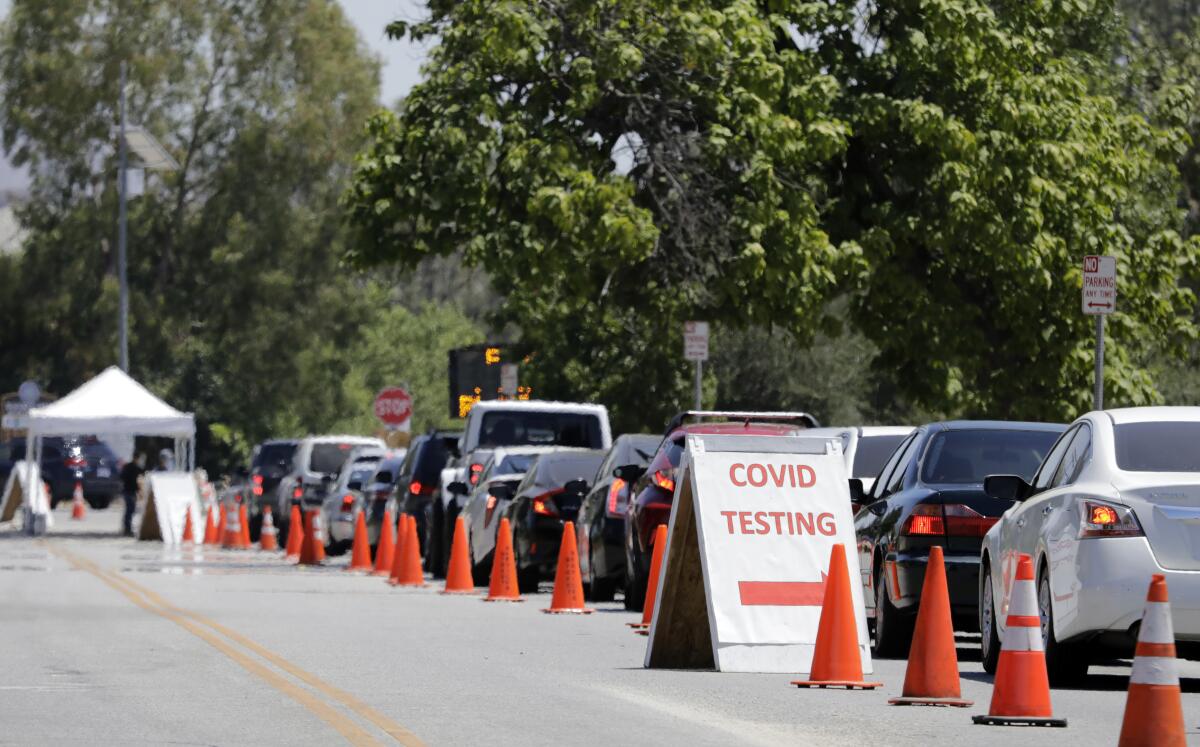Newsletter: The current COVID-19 landscape

Good morning, and welcome to the Essential California newsletter. It’s Thursday, July 30, and I’m writing from Los Angeles.
Sign up for Essential California
The most important California stories and recommendations in your inbox every morning.
You may occasionally receive promotional content from the Los Angeles Times.
For the third time this month and the second time this past week alone, California has again broken a new record for the most coronavirus-related deaths in a single day, with 174 deaths reported on Tuesday. The daily average of coronavirus-related deaths in the state over the previous seven days is now at 119, which is the highest it’s been since the pandemic began.
[Read the story: “California again breaks record for most coronavirus deaths in a single day” in the Los Angeles Times]
Meanwhile, Los Angeles County recorded its own new daily record for fatalities, with 91 deaths Wednesday. Three of the newly reported deaths were among people between the ages of 18 and 29, an age group that accounts for just 0.6% of the county’s total deaths. One of those three individuals did not have any known underlying health conditions.
It’s clear that the statewide surge has yet to be stymied, but there are some signs that its growth has begun to slow down. Let’s take a look at the numbers, as analyzed by my colleagues Ron Lin, Iris Lee and Priya Krishnakumar.
Yes, the average number of cases confirmed over the past week is still slightly up compared to the week before. But that 2% week-over-week average daily rise in new cases recorded on Tuesday is tiny compared to what we saw on the same day two weeks prior, when the week-over-week average daily number of cases had jumped a staggering 20%. And the state’s seven-day coronavirus positive test rate has generally stayed steady between 7% and 8% since the first week of July.
These are all promising signs. But, to borrow one of Gov. Gavin Newsom’s favorite coronavirus news briefing catchphrases, none of us live in the aggregate. And as my colleagues explain in their story, looking at these averages alone conceals the deep problems in harder-hit areas of California.
The situation has rapidly deteriorated in the Central Valley, with a surge that has taken a particular toll on farmworkers. Earlier this week, Newsom announced that he would send “strike teams” to eight counties in the San Joaquin Valley while asking the California Legislature to approve $52 million to improve testing, tracing and isolation protocols in those regions.
[Read the story: “Coronavirus ravages California’s Central Valley, following a cruel and familiar path” in the Los Angeles Times]
Deaths are also rising in the broader Sacramento region, the Bay Area and Southern California.
And testing continues to present issues. As my colleague Emily Baumgaertner reports in a new story, the state’s coronavirus testing task force has shrunk in size and influence, even as the state now grapples with surging infection rates and looming test supply shortages. Dozens of task force members have departed and not been replaced, and the senior health official who oversaw the team has resigned.
[Read the story: “California scales back coronavirus testing task force despite long lines, shortages, new outbreaks” in the Los Angeles Times]
The diminished state of the task force has raised alarms for some experts and former members who say a fully staffed team is needed more than ever to help a public health department that is chronically understaffed and ill-equipped to respond to emergencies on their own. Meanwhile, California is still conducting less than half the daily tests necessary to stop the virus, according to an analysis by the Harvard Global Health Institute.
And now, here’s what’s happening across California:
California won’t conquer the coronavirus, and fully reopen, until it can protect essential workers. From farming communities to urban centers and suburbs, workers in retail, manufacturing, agriculture and logistics are bearing the brunt of COVID-19 outbreaks, and state and local officials are struggling to control the infections even as the outlook in more prosperous communities has improved. Los Angeles Times
A dispute between LAUSD and teachers over online learning keeps L.A. parents in limbo: With the Aug. 18 start of the school year fast approaching, parents and students face uncertainty over how online instruction will be conducted as the Los Angeles teachers union and district officials haggle over distance learning rules and schedules. Los Angeles Times
L.A. STORIES
A heat wave is set to roll into Southern California beginning Thursday — bringing dangerous temperatures and potentially hazardous fire conditions to the region. Los Angeles Times
Her famous dad’s a fan. So is Phoebe Bridgers. But Gracie Abrams has a voice all her own. Los Angeles Times

Black Restaurant Week returns to Los Angeles: The restaurant week, which will run Aug. 7-16, is part of a larger, ongoing effort to support Black-owned businesses in Los Angeles. Los Angeles Times
Dodgers pitcher Joe Kelly will be benched for eight games after incidents in Tuesday’s game against the Houston Astros. The league said Kelly was suspended for throwing a pitch “in the area of the head of Alex Bregman and later taunted Carlos Correa, which led to the benches clearing.” Los Angeles Times
Support our journalism
POLITICS AND GOVERNMENT
President Trump repealed a rule meant to integrate neighborhoods, further stoking racial divisions in the campaign. The announcement may have less practical effect in California than elsewhere in the country. In 2018, after plans to unwind the Obama fair housing rule were first announced, state legislators passed a bill enshrining a similar effort in state law. Los Angeles Times
Google’s Sundar Pichai, Amazon’s Jeff Bezos, Facebook’s Mark Zuckerberg and Apple’s Tim Cook were grilled for more than five hours by a House subcommittee. Members of Congress were in rare bipartisan accord as they fixed their sights on a common enemy: the Silicon Valley titans, and their perceived abuses of power. Subcommittee members occasionally deviated from the topic of antitrust concerns, touching on other politically contentious issues, including alleged foreign interference in U.S. elections and the companies’ contracts with the U.S. military and local police. Los Angeles Times
(For those who only care about the important things, here’s what the Room Rater Twitter account had to say about the home setups of Bezos, Zuckerberg, Cook and Pichai, as seen in the backgrounds of their remote testimony.)
Gov. Newsom announced a “strike team” for California’s unemployment agency. Facing a flood of complaints from jobless Californians who have been unable to obtain unemployment benefits, Newsom said Wednesday that a newly formed team will address issues with the system and streamline the process for resolving claims. Los Angeles Times
California is considering a strict “George Floyd” law to punish police who fail to intervene. If enacted, the proposed law would put California at the forefront of legal efforts to criminalize the “blue code of silence” that many say contributed to Floyd’s death. Los Angeles Times
Orange County Republicans hold in-person fundraisers even as the coronavirus spreads: Candidates say they’re being careful, but a yacht party, cigar reception and other events have raised flags for health experts — and some GOP strategists. Orange County Register
CRIME AND COURTS
A longtime Los Angeles police SWAT sergeant is suing the LAPD, alleging the unit is run by a “SWAT Mafia” of veteran cops who encourage the use of deadly force and ostracized him for revealing its behavior. Los Angeles Times
The Orange County Board of Education doubled down on its battle over coronavirus school closure orders, voting to sue the governor in an effort to open campuses across high-risk counties. Los Angeles Times
HEALTH AND THE ENVIRONMENT
All California counties now have coronavirus cases as Modoc County confirms its first two cases. As cases surged throughout the state and ravaged nearby counties in Northern California, Modoc had remained untouched by the virus until now. Los Angeles Times
CALIFORNIA CULTURE
The pandemic-era appeal of getting lost in a labyrinth. While institutional projects have dwindled, a Bay Area-based labyrinth maker has seen a surge in homeowners hoping to build private backyard labyrinths. Bloomberg
Fifty-seven years ago, George Hartman had a one-night stand after a night of partying in Old Town Eureka. A lifetime later, a niece gifted him with a “23 and Me” DNA kit to learn more about his ancestry. This spring, Hartman, who is now 83 and lives in Crescent City, discovered more than he bargained for — a daughter he never knew he’d fathered, living 702 miles away in the Mojave Desert. Amid an unrelenting pandemic, the two found each other and forged a phone relationship. Last week, Patricia Stanberry finally made the 12-hour drive north to meet her father. “The Mojave Desert doesn’t have trees and she’d never been in redwood country,” Hartman said. “We drove around the old 101. Toured the lily fields and blew my transmission on the last day coming back to town.” It felt like they’d known each other for ages. Del Norte Triplicate
A poem to start your Thursday: “Yes” by William Stafford. Reflections
Free online games
Get our free daily crossword puzzle, sudoku, word search and arcade games in our new game center at latimes.com/games.
CALIFORNIA ALMANAC
Los Angeles: partly cloudy, 89. San Diego: partly cloudy, 78. San Francisco: sunny, 66. San Jose: partly cloudy, 80. Fresno: sunny, 102. Sacramento: sunny, 98. More weather is here.
AND FINALLY
Today’s California memory comes from Mauriça Anderson:
If you ordered orange juice in a restaurant in the early 1950s in California, you were given awful stuff out of a can. But it was a pure pleasure when my mom would pull to a stop at one the many small buildings along Highway 99 whose signs said ‘Giant Orange,’ and to my delight looked just like oranges. You could buy huge glasses of sweet, freshly squeezed orange juice for 25 cents.
If you have a memory or story about the Golden State, share it with us. (Please keep your story to 100 words.)
Please let us know what we can do to make this newsletter more useful to you. Send comments, complaints, ideas and unrelated book recommendations to Julia Wick. Follow her on Twitter @Sherlyholmes.
Sign up for Essential California
The most important California stories and recommendations in your inbox every morning.
You may occasionally receive promotional content from the Los Angeles Times.




